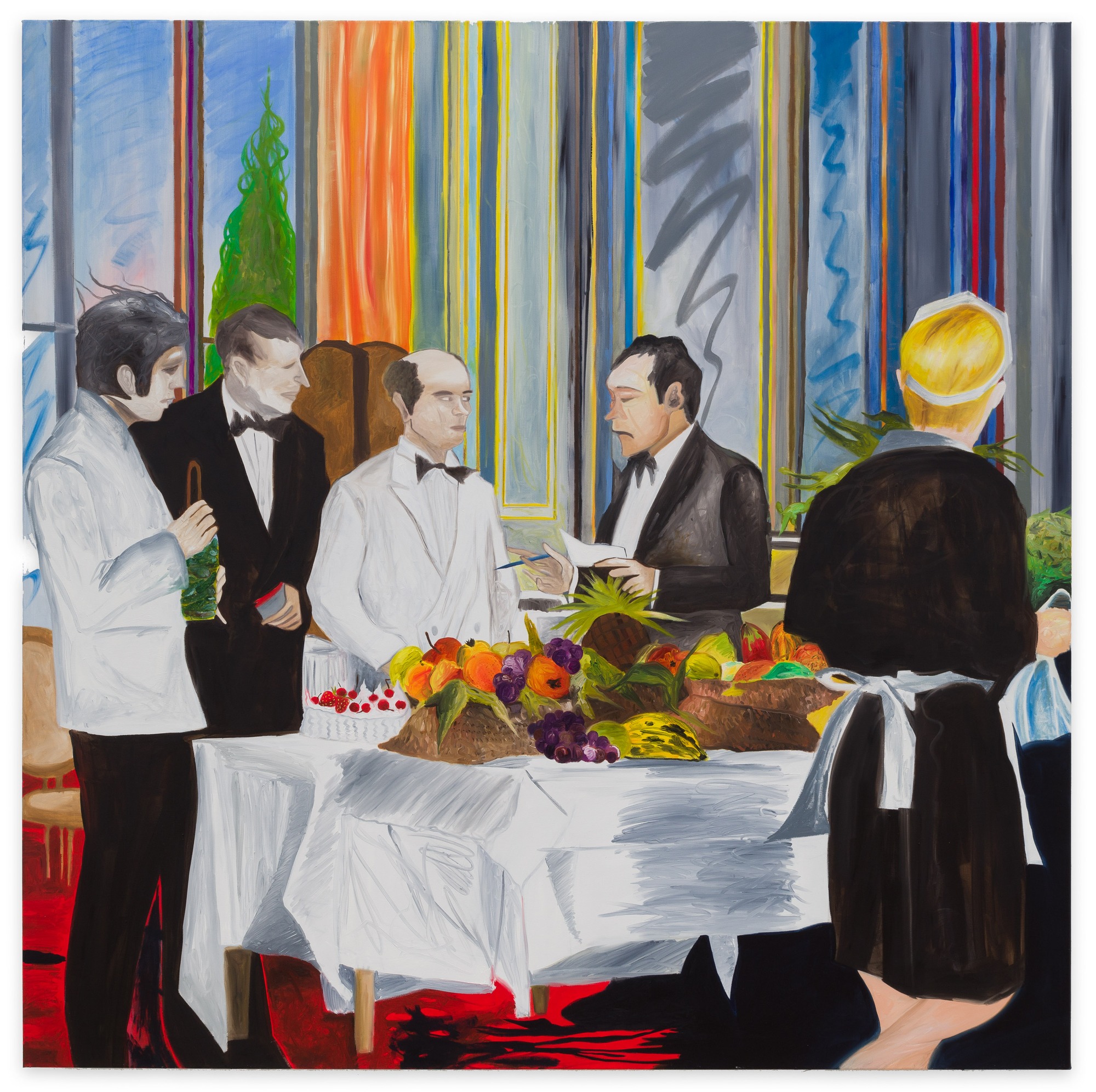Alexander Ruthner
Amygdala Ikebana
25 Jan - 02 Mar 2019

Alexander Ruthner
Vor dem Brunch, 2019
Öl auf Leinwand
200 x 200 cm
Courtesy Gabriele Senn Galerie, Foto: Maximilian Anelli-Monti
Vor dem Brunch, 2019
Öl auf Leinwand
200 x 200 cm
Courtesy Gabriele Senn Galerie, Foto: Maximilian Anelli-Monti
ALEXANDER RUTHNER
Amygdala Ikebana
25 January - 2 March 2019
„The more I am with you,
the clearer I see:
you touch your phone
more than you touch me.”
Klara Kayser, Protein (2017)
The amygdala (ancient Greek ἀμυγδάλη, German, “almond kernel”) lies at the center of the brain and is instrumental in the conditioning of fear and anxiety. It connects events with emotions, which makes it essential in the accurate and often vitally important assessment of everyday situations. As well as processing external impulses, the amygdala also remembers dangerous situations and re-activates previously experienced somatic reactions such as panic, apathy and powerlessness when faced with similar conditions - these situations are known as triggers.
Alexander Ruthner's pieces can be understood as triggersof sorts. They are fragments from a lexicon of pictures collected by the artist that supposedly reminds the viewer of that which has “already been experienced” in digital media such as film, computer gaming and social media. The pieces though, don’t reproduce clear symbols from collective memory that could be recognized just by identifying them. In Amygdala Ikebana,natural landscapes and figurative, realistic-looking pieces are juxtaposed as two separate groups of work. Wild grasses come together reflexively to form a poetic conceptualization. Meadow tableaus are a constant in Ruthner's work. These are recycled and expanded upon as a subject again and again. They could be based in a paranoid, primitive state of man, similar to the phase that lies between sleep and wakefulness from which one must resurface anew again and again. A proposal, carelessly offered up to the viewer: laugh, cry, be irritated, be afraid.
The decorative scenic atmosphere masks the psychological complexity that underlies Ruthner's figures and abstractions. InVor dem Brunch (engl. Before Brunch),the figures, affective in their mannerisms, play with behavioral patterns.Gender attributes and authority are negotiated via a rigid meeting, whereby the choice of psychedelic colours and mask-like facial features let one dissociate the familiar and transport it into the world of the unconscious.The seemingly realistic situation calls into question our ability to 'faithfully' reproduce images.
The exhibition completes the “Meadow Tableaus” series with “screens”, which have their origins in Asia. The natural environment of the “screen” is made up of myths and secrecy. For this reason, Byobu 1/ Flex affords visitors the opportunity to escape unwanted glances and marks out a (shame-) border with the help of a screened-off, private area. In Western history, this has traditionally been associated with the female.
Landscapes that provide an escape from urbanized spaces into complete desolation form a bridge to digital reality in which a large part of our lives take place. The exhibition raises the question of where spaces for self-determination are moving to: from nature to the indoors, from the community to the individual, from the body to the display?
- Nicole Damblon
Amygdala Ikebana
25 January - 2 March 2019
„The more I am with you,
the clearer I see:
you touch your phone
more than you touch me.”
Klara Kayser, Protein (2017)
The amygdala (ancient Greek ἀμυγδάλη, German, “almond kernel”) lies at the center of the brain and is instrumental in the conditioning of fear and anxiety. It connects events with emotions, which makes it essential in the accurate and often vitally important assessment of everyday situations. As well as processing external impulses, the amygdala also remembers dangerous situations and re-activates previously experienced somatic reactions such as panic, apathy and powerlessness when faced with similar conditions - these situations are known as triggers.
Alexander Ruthner's pieces can be understood as triggersof sorts. They are fragments from a lexicon of pictures collected by the artist that supposedly reminds the viewer of that which has “already been experienced” in digital media such as film, computer gaming and social media. The pieces though, don’t reproduce clear symbols from collective memory that could be recognized just by identifying them. In Amygdala Ikebana,natural landscapes and figurative, realistic-looking pieces are juxtaposed as two separate groups of work. Wild grasses come together reflexively to form a poetic conceptualization. Meadow tableaus are a constant in Ruthner's work. These are recycled and expanded upon as a subject again and again. They could be based in a paranoid, primitive state of man, similar to the phase that lies between sleep and wakefulness from which one must resurface anew again and again. A proposal, carelessly offered up to the viewer: laugh, cry, be irritated, be afraid.
The decorative scenic atmosphere masks the psychological complexity that underlies Ruthner's figures and abstractions. InVor dem Brunch (engl. Before Brunch),the figures, affective in their mannerisms, play with behavioral patterns.Gender attributes and authority are negotiated via a rigid meeting, whereby the choice of psychedelic colours and mask-like facial features let one dissociate the familiar and transport it into the world of the unconscious.The seemingly realistic situation calls into question our ability to 'faithfully' reproduce images.
The exhibition completes the “Meadow Tableaus” series with “screens”, which have their origins in Asia. The natural environment of the “screen” is made up of myths and secrecy. For this reason, Byobu 1/ Flex affords visitors the opportunity to escape unwanted glances and marks out a (shame-) border with the help of a screened-off, private area. In Western history, this has traditionally been associated with the female.
Landscapes that provide an escape from urbanized spaces into complete desolation form a bridge to digital reality in which a large part of our lives take place. The exhibition raises the question of where spaces for self-determination are moving to: from nature to the indoors, from the community to the individual, from the body to the display?
- Nicole Damblon
